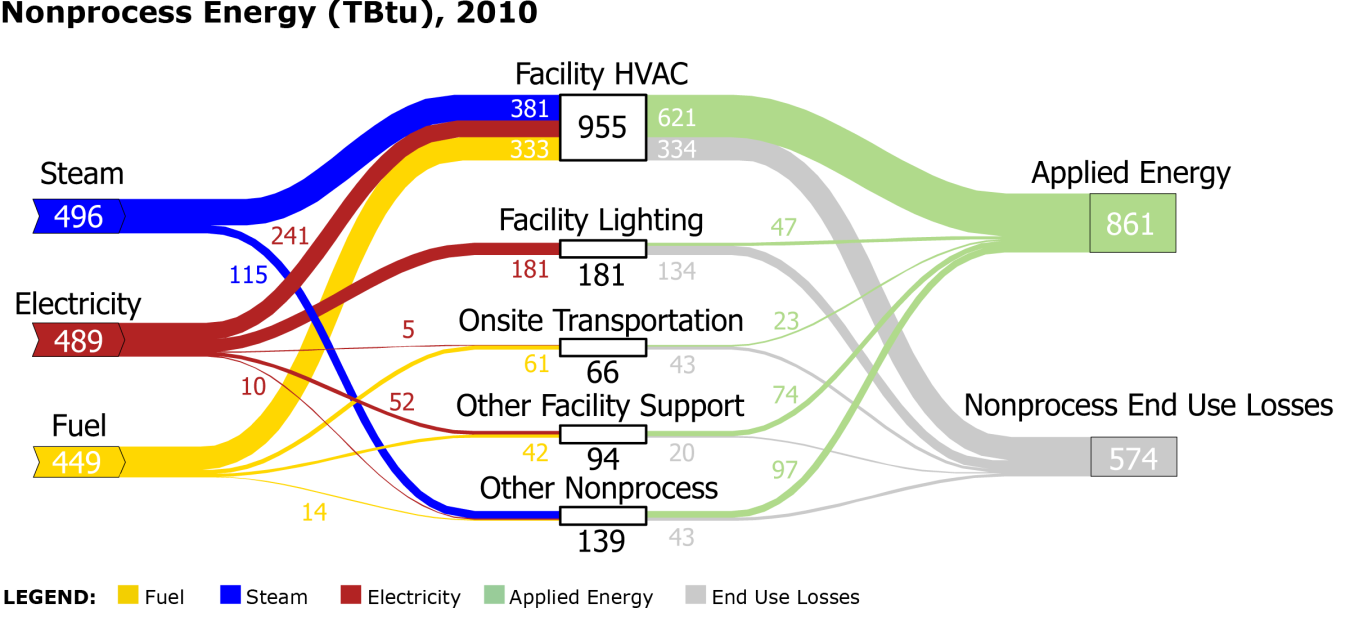Note: The Static Sankey diagrams were updated in May 2019 (available here) with the latest U.S. Energy Information Administration (EIA) Manufacturing Energy Consumption Survey (MECS) data for 2014 and updated assumptions.
The Nonprocess Energy Static Sankey diagram shows how energy is used for supporting functions by U.S. manufacturing plants, based on EIA MECS data for 2010.
Click on the Full Sector, Onsite Generation, and Process Energy thumbnails below the diagram to see further detail on energy flows in manufacturing. Also, see the Dynamic Manufacturing Energy Sankey Tool to pan, zoom, and customize the manufacturing Sankey data and compare energy consumption across manufacturing subsectors (this tool is only available for 2010 MECS data).
The Nonprocess Energy diagram below shows inputs of steam, electricity, and fuel to “nonprocess” end uses in the U.S. manufacturing sector (NAICS 31-33). Nonprocess applications that use this energy include facility heating, ventilation, and air conditioning (HVAC), facility lighting, onsite transportation, other facility support (e.g., cooking, water heating), and other nonprocess uses. Energy is lost during the transformation of steam, electricity, and fuel into useful work (e.g., facility ventilation, nonprocess transportation) and heat (e.g., space heating, water heating). Applied Energy is the energy consumed in these nonprocess applications that translates directly into useful work and heat. It is determined by subtracting the end use losses from the total energy consumed for each nonprocess application.
These diagrams visually complement the 2010 MECS data Manufacturing Energy and Carbon Footprint analysis. Definitions of terms used in this Sankey diagram are at the bottom of this page.

Data source: 2010 Manufacturing Energy and Carbon Footprint
TERMINOLOGY
Applied Energy: Amount of total primary energy employed in direct end use.
Facility HVAC: The direct nonprocess end use that includes energy used to provide heating, ventilation, and air conditioning for building envelopes within the industrial plant boundary.
Facility Lighting: The direct nonprocess end use that includes energy used in equipment that illuminates buildings and other areas within the industrial plant boundary.
Nonprocess End Use Losses: Energy that is lost during the transformation of steam, electricity, and fuel into useful work and heat for nonprocess applications.
Nonprocess Energy: Energy used for purposes other than converting raw material into manufactured product. MECS-specified categories of nonprocess energy include facility HVAC, facility lighting, onsite transportation, other facility support (e.g., cooking, water heating), and other nonprocess use.
Onsite Transportation: The direct nonprocess end use that includes energy used in vehicles and transportation equipment that primarily consume energy within the boundaries of the establishment.
Other Facility Support: The direct nonprocess end use that includes energy used in diverse applications that are normally associated with office or building operations such as cooking, operation of office equipment, and the operation of elevators.
Other Nonprocess: The direct nonprocess end use that includes energy used for nonprocess uses other than the defined nonprocess energy categories (e.g., cleaning equipment, pressure washing, testing equipment, maintenance tools).
ACRONYM
HVAC: Heating, Ventilation, and Air Conditioning
NOTES
- The data source for this Sankey Diagram is the 2010 MECS data Manufacturing Energy and Carbon Footprint. The footprint analysis utilizes 2010 EIA Manufacturing Energy Consumption Survey (MECS) data, with adjustments, to quantify steam generation, electricity generation, and incoming fuel; onsite steam and electricity generation; and end use of electricity and fuel. Steam end use is not provided by MECS but rather is dependent on analysis alone.
- Energy values represent aggregate sector-wide data for 2010 in TBtu/yr, rounded to nearest whole number
- Excludes feedstock energy (byproduct fuels from feedstock are included)
- Arrow and box heights are proportional to flow size except for small flows for visual convenience
- Energy losses do not equate to recoverable energy, as a portion of these losses are thermodynamically unrecoverable
- Offsite generation shown on net basis (purchases, sales, and transfers accounted for)
- Offsite and onsite generation, offsite transmission, and onsite steam distribution losses are not included in the Nonprocess Sankey





